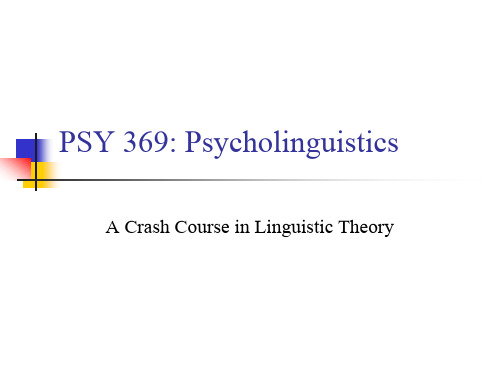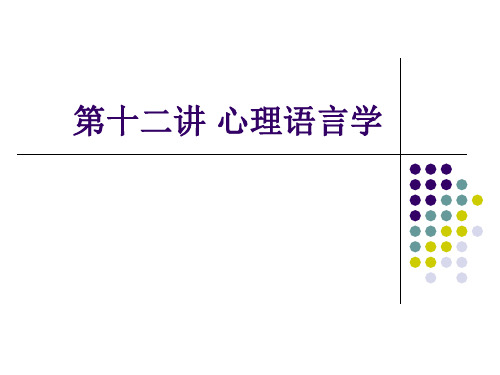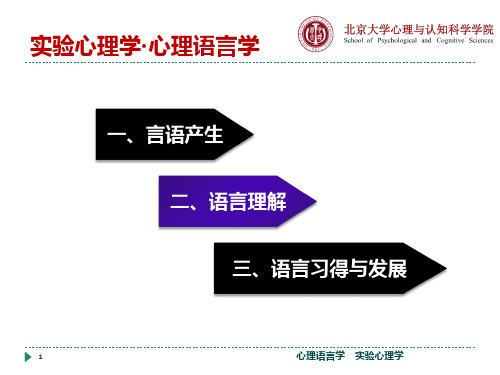国外心理语言学课件12
合集下载
《心理语言学》课件

05
心理语言学面临的挑战与展望
跨文化研究挑战
文化差异对心理语言学的影响
不同文化背景下的语言使用和认知方式存在差异,如何克服这些差异,建立跨文 化的心理语言学理论是当前面临的重要挑战。
语言与文化的关系
语言是文化的重要组成部分,语言使用和认知方式受到文化的影响。在跨文化研 究中,需要深入探讨语言与文化的关系,以及文化如何影响心理语言学的理论构 建。
研究目的和意义
研究目的
探究语言的认知过程,理解语言与思 维、认知之间的相互作用,为语言障 碍和语言习得的深入研究提供理论基 础。
研究意义
有助于提高语言教育的质量,促进跨 文化交流,为语言障碍的干预和治疗 提供指导。
研究历史与发展
研究历史
心理语言学作为一门独立的学科,起 源于20世纪50年代的美国。早期研究 主要关注语言处理过程中的心理机制 ,随着研究的深入,逐渐形成了系统 的理论体系。
语言障碍治疗
1 2
语言障碍评估
心理语言学对语言障碍的评估标准和方法进行研 究,为语言障碍治疗提供科学依据。
治疗方法
基于心理语言学的理论和方法,开发针对不同语 言障碍的治疗方案,帮助患者恢复语言功能。
3
康复训练
心理语言学在语言障碍康复训练中发挥重要作用 ,为患者提供个性化的康复训练计划,提高康复 效果。
人工智能与机器翻译
自然语言处理
01
心理语言学对自然语言处理的研究,为人工智能和机器翻译技
术的发展提供理论支持。
机器翻译质量评估
02
基于心理语言学的评价标准和方法,对机器翻译的质量进行评
估和改进,提高机器翻译的准确性和流畅性。
人机交互
03
心理语言学在人机交互领域的应用,有助于设计更符合人类语
国外心理语言学课件3

Rules about how to put the sounds together
Includes sound structures like syllables, onsets, rhymes
Phonology
allophones pill Listen to the ‘p’ sound spill [p] [ph] /p/ phonemes
full chart Symbols and sounds
Glottal
Fricatives
Affricates
Nasals Liquids
lateral nonlateral Glides
l voiced voiced w r y
See Table 2.3 of textbook, pg 32
Phonemeical reality of phonemes
Liberman et al (1957) categorical perception of phonemes
Presented consonant-vowel syllables along a continuum The consonants were /b/, /d/, and /g/, followed by /a/
unhappiness horses talking
Morphology
Morpheme Productivity
Free morphemes: can stand alone as words Bound morphemes: can not stand alone as words
Affixes, pre-fixes, suffixes, infixes
In Classic Greek every verb has 350 forms
NLP培训PPT课件

性。
解决方法:采用深度学习、知识 图谱等技术,提高模型对语义的
认知和理解能力。
语言理解的哲学问题
语言理解的哲学问题主要涉及语 言与思维的关系、语言的本质等
问题。
这些问题对于自然语言处理的发 展具有重要影响,需要深入探讨
和思考。
解决方法:需要跨学科合作,结 合哲学、语言学、心理学等多学 科知识,共同推进语言理解的研
语境与语义
语境
指语言使用的环境,包括 时间、地点、人物等背景 信息。
语义
指语言符号所表达的意义 ,包括词汇意义、语法意 义和语境意义。
语境对语义的影响
语境可以影响语义的理解 和表达,同一句话在不同 语境下可能有不同含义。
语言与认知
认知
指人类获取、处理和使用信息的心理过程。
语言与认知的关系
语言是认知的载体和工具,认知通过语言来表达和交流。
过拟合问题
由于训练数据有限,模型容易在训练数据上表现良好,但 在测试数据上表现较差,即出现过拟合现象。
解决方法
采用数据增强、迁移学习等技术,提高模型的泛化能力。
语义鸿沟问题
语义鸿沟是指自然语言处理中, 语言Leabharlann 号与真实世界之间的认知距离。
语义鸿沟的存在使得机器难以理 解人类语言的真正含义,从而影 响自然语言处理的准确性和可靠
词法分析
总结词
词法分析是对文本进行分词,将连续的文本划分为独立的词 汇或词素。
详细描述
词法分析是NLP中的重要环节,主要是将连续的文本切分成 一个个独立的词汇或词素。分词的准确性直接影响到后续句 法分析和语义分析的效果。常用的分词方法有基于规则的分 词和基于统计的分词。
句法分析
总结词
句法分析研究句子中词语之间的结构关系,识别句子的主语、谓语、宾语等成分 。
解决方法:采用深度学习、知识 图谱等技术,提高模型对语义的
认知和理解能力。
语言理解的哲学问题
语言理解的哲学问题主要涉及语 言与思维的关系、语言的本质等
问题。
这些问题对于自然语言处理的发 展具有重要影响,需要深入探讨
和思考。
解决方法:需要跨学科合作,结 合哲学、语言学、心理学等多学 科知识,共同推进语言理解的研
语境与语义
语境
指语言使用的环境,包括 时间、地点、人物等背景 信息。
语义
指语言符号所表达的意义 ,包括词汇意义、语法意 义和语境意义。
语境对语义的影响
语境可以影响语义的理解 和表达,同一句话在不同 语境下可能有不同含义。
语言与认知
认知
指人类获取、处理和使用信息的心理过程。
语言与认知的关系
语言是认知的载体和工具,认知通过语言来表达和交流。
过拟合问题
由于训练数据有限,模型容易在训练数据上表现良好,但 在测试数据上表现较差,即出现过拟合现象。
解决方法
采用数据增强、迁移学习等技术,提高模型的泛化能力。
语义鸿沟问题
语义鸿沟是指自然语言处理中, 语言Leabharlann 号与真实世界之间的认知距离。
语义鸿沟的存在使得机器难以理 解人类语言的真正含义,从而影 响自然语言处理的准确性和可靠
词法分析
总结词
词法分析是对文本进行分词,将连续的文本划分为独立的词 汇或词素。
详细描述
词法分析是NLP中的重要环节,主要是将连续的文本切分成 一个个独立的词汇或词素。分词的准确性直接影响到后续句 法分析和语义分析的效果。常用的分词方法有基于规则的分 词和基于统计的分词。
句法分析
总结词
句法分析研究句子中词语之间的结构关系,识别句子的主语、谓语、宾语等成分 。
第十二讲 心理语言学

主要的实验技术和手段包括(余林等, 1999): 移动视窗(moving window)技术:通过计算机逐词或多词呈现的方式进行,被试通过按键使 计算机屏幕逐词或多词呈现实验材料,阅读的速度由被试的按键速度所决定,因而又称自定 步速的阅读。被试按键时由计算机自动记录下他在各词上的停留时间,以此作为阅读时间来 研究被试在阅读加工过程中所遇到的加工困难。 跨通道启动(cross-model priming)技术:一般是通过耳机听觉呈现刺激材料,然后在句子不 同位置由计算机屏幕呈现启动词,并让被试对启动词进行词汇判断或命名,视觉启动词的呈 现位置和时间由计算机精确控制,并由其记录下被试对探测词的反应时间和错误率,以此来 研究探测词受到句子加工中语义和句法关系制约的情况。 眼动技术(eye-movement technique):此技术通过专门的眼动仪(eye tracker)来追踪被试在 屏幕上的注视点,实验材料由计算机呈现,并通过眼动仪与计算机的连接记录被试在句中各 词上的停留时间和回扫、眼跳等资料,通过分析被试在各种控制条件下行为反应上的差异来 了解被试的即时加工过程,此种方法接近于自然条件下的阅读状况。 事件相关电位(event-related potentials):通过计算机收集和处理大脑加工句子信息时的脑 电活动的方法,直接探测人在阅读过程中所引起的脑电变化,以此获得人在加工不同控制条 件下句子时的脑电模式来推测句子加工的时间进程。在句子加工中发现了两种相对稳定的脑 电波N400与P600。前者是指句中关键词呈现400毫秒后所记录到的一个负的脑电波,它与词 汇的语义 (特别是主题限制)有关;后者是指在关键词呈现600毫秒后记录到的一个正的脑电 波,研究认为它与句子的句法有关。
poeppel2004一些言语知觉范式现象范畴知觉选择性适应任务mcgurk效应听觉pa视觉ka知觉taduplex知觉范畴知觉物理刺激连续变化对应的知觉表现出范畴性变化材料最小的语音范畴对比听觉词汇识别spokenwordrecognition视觉词汇识别visualwordrecognition听觉词汇识别cohort模型marlsenwilson1987第一个阶段对输入信息进行听觉语音分析激活一群可供选择的单词即初始词群第二阶段当语音信息继续仍然符合语音输入的词的激活水平增加而不符合语音输入的词的激活水平下降直到选中群中的一个词最后把选中的词整合到当前语义和句法情境中
课件:心理语言学:CH7 Speech production

• Unfilled pauses: a moment of silence (hesitation > 200 msec), occurs ~ every 5-8 words in picture describing experiments, and every 7-8 words in conversations.
for listener. • Pauses of different length reflect different processes. Goldman-
Eisler suggests that pauses < 250 msec reflect articulation difficulties rather than planning time. Challenged by Beattie and Bradbury, 1979, when pause rates artificially reduced there are more repetitions instead. • Early work was used to argue that pausing reflected semantic planning, but it could also reflect difficulty of retrieving complex or infrequently used phonological form or of syntactic planning.
Cattle ships and bruisers Battle ships and cruisers
..we’ll have the hags flung out
..we’ll have the flags hung out
for listener. • Pauses of different length reflect different processes. Goldman-
Eisler suggests that pauses < 250 msec reflect articulation difficulties rather than planning time. Challenged by Beattie and Bradbury, 1979, when pause rates artificially reduced there are more repetitions instead. • Early work was used to argue that pausing reflected semantic planning, but it could also reflect difficulty of retrieving complex or infrequently used phonological form or of syntactic planning.
Cattle ships and bruisers Battle ships and cruisers
..we’ll have the hags flung out
..we’ll have the flags hung out
实验心理学 第十二章——心理语言学——第2部分

85ms SOA
反应时 错误率
515** 1.3 544 0.7 534* 4.0 550 2.8
145ms SOA
反应时 错误率
533** 1.0
542 * 2.0
547* 3.8
565
1.1
音同启动效应已经出现,但是只表现在促进目标字的精确判断这一指标上。
12
心理语言学 实验心理学
二、语言理解:视觉词汇通达
beach
XXX 200ms
nut
15
例如, 当目标词是nut(坚果)时, 启动词可以是目标词的语义相 关词beech(山毛榉树) 目标词语义相关词的同音词 beach(海滩) 目标词语义相关词的形似词 bench(长椅子) 或者无关词badminton(羽 毛球)。
565
1.1
字形最先得到加工。
10
心理语言学 实验心理学
二、语言理解:视觉词汇通达
基于语义的任务结果
四种SOA条件下,高频目标汉字的反应时(ms)和错误率(%)
启动条件
形似启动 音同启动 义近启动 无关启动
43ms SOA
57ms SOA
85ms SOA
反应时 错误率 反应时 错误率 反应时 错误率
3
心理语言学 实验心理学
二、语言理解
词汇
语句
篇章
4
心理语言学 实验心理学
二Байду номын сангаас语言理解
词汇理解
• 视觉词汇通达 • 听觉词汇通达
语句理解
• 模块化理论 • 交互作用理论
篇章理解
• 情境模型 • 情境模型发展
5
心理语言学 实验心理学
二、语言理解:视觉词汇通达
心里语言学ppt课件

辨听,到单词的提取以至到语意的联接和确认,讨Байду номын сангаас言语产生的过程以及影响言语产生的各种因素。
语言习得: “语言习得”,不但是心理学和语言学共同关心
的话题,而且也是心理语言学重点研究的课题之一。该领
域的研究主要包括:(1)语言发展的研究方法;(2)言语感
知的发展;(3)儿童语言词汇;(4)句子的学习及理解;(5)
语言理解 : “语言理解”是心理语言学集中讨论的话题,其研
究包括:(1)言语感知;(2)词汇提取;(3)句子加工;(4)语篇理
解。简而言之,就是研究人们是如何理解语言的。
“语言理解”是心理语言学集中讨论的话题,其研究包括:(1)言语感知;(2)词汇提取;(3)句子加工;(4)语篇理解。简而言
心理语言学
定义 主要研究对象 基本发展概况 基本研究方法 主要研究成果 主要价值发展前景 亟待解决的问题
定义:心理语言学是研究语言活动中的心理过程的学科,它涉 及人类个体如何掌握和运用语言系统,如何在实际交往中使语 言系统发挥作用,以及为了掌握和运用这个系统应具有什么知 识和能力。从信息加工的观点来看,心理语言学是研究个体言 语交往中的编码和译码过程。由于研究对象的特点,它与许多 学科有密切关系,除心理学和语言学外,还有信息论、人类学 等。在方法上,它主要采用实验心理学的方法。
语言的交际用途;(6)儿童语言习得理论。
首先,在语言发展研究方法的探索方面,利奥颇尔德(Leopold,1948)提出的“日记和家长报告”为研究儿童语言的发展提供了 一个重要的途径。利奥颇尔德通过对其女儿希尔得嘉德(Hildegarde)在英语和德语学习方面所取得的进步的观察认为,观察和 研究儿童日记的语言发展有助于对儿童语言发展的有效研究。但后来贝茨(Bares,1991)却认为更有效的途径是家长对其子女语 言表现的观察。因此,儿童日记和家长报告就成了研究儿童语言发展的一大途径。除此之外,观察数据、采访和实验也是研究 语言发展的重要方法。第二,言语感知发展的研究包括3个方面的研究:(1)家长的语言输出和儿童语言学习的关系;(2)儿童早 期言语感知;(3)语言特化。第三,儿童语言词汇研究包括:咿呀学语、单词学习、双词学习、语法联接、词语和词义联接。在 这方面,其研究的重心集中在“词汇和语法知识的获得”、“使用语言能力的获得”和“词语与语义的连接”3个方面。第四 ,句子学习和理解主要包括4个方面的研究:(1)单词和短语向简单句的过渡过程;(2)语法在造句方面所起的作用;(3)句子的形 成 和 理 解 策 略 ; (4) 简 单 句 向 复 杂 句 的 过 渡 以 及 对 较 为 复 杂 语 句 的 理 解 和 使 用 。 第 五 , 在 语 言 交 际 用 途 的 研 究 方 面 , 贝 茨 (Bates,1976)和韩礼德(Halliday,1975)提出的“语用学功能”、奈尔森(Nelson,1973)提出的“指涉和表达功能”成为研究语言功 用的主要理论基础。特别是韩礼德提出的7种语言功能,不但成为语言学研究的一个经典,同时也为心理语言学在语言习得理 论的研究方面提供了一条重要的思考线索。第六,儿童语言习得的过程和方式为语言习得的理论研究提供了重要的思考途径。 但就儿童语言习得理论的研究而论,以斯金纳和布龙费尔德“刺激—反应”或“强化”论为代表的行为主义理论、以乔姆斯基 “天生论”为代表的“遗传”或“传递”理论构成了儿童语言习得理论研究的两大分支。此外,以皮亚杰(Piaget)和布鲁纳 (Bruner)为代表的“认知”理论、由贝茨(Bates)和麦克威尼(MacWhinney)提出的“竞争模型”和由波特提出的“交互作用模型 ”代表了儿童语言习得模型研究的主体内容。由此可见,行为主义的“刺激—反应”理论,心灵主义的“内在”理论,交互作 用理论的“认知”、“信息处理”和“社会交互作用”理论构成了研究儿童语言习得理论的核心,是研究儿童语言习得理论的 重要基础。
语言习得: “语言习得”,不但是心理学和语言学共同关心
的话题,而且也是心理语言学重点研究的课题之一。该领
域的研究主要包括:(1)语言发展的研究方法;(2)言语感
知的发展;(3)儿童语言词汇;(4)句子的学习及理解;(5)
语言理解 : “语言理解”是心理语言学集中讨论的话题,其研
究包括:(1)言语感知;(2)词汇提取;(3)句子加工;(4)语篇理
解。简而言之,就是研究人们是如何理解语言的。
“语言理解”是心理语言学集中讨论的话题,其研究包括:(1)言语感知;(2)词汇提取;(3)句子加工;(4)语篇理解。简而言
心理语言学
定义 主要研究对象 基本发展概况 基本研究方法 主要研究成果 主要价值发展前景 亟待解决的问题
定义:心理语言学是研究语言活动中的心理过程的学科,它涉 及人类个体如何掌握和运用语言系统,如何在实际交往中使语 言系统发挥作用,以及为了掌握和运用这个系统应具有什么知 识和能力。从信息加工的观点来看,心理语言学是研究个体言 语交往中的编码和译码过程。由于研究对象的特点,它与许多 学科有密切关系,除心理学和语言学外,还有信息论、人类学 等。在方法上,它主要采用实验心理学的方法。
语言的交际用途;(6)儿童语言习得理论。
首先,在语言发展研究方法的探索方面,利奥颇尔德(Leopold,1948)提出的“日记和家长报告”为研究儿童语言的发展提供了 一个重要的途径。利奥颇尔德通过对其女儿希尔得嘉德(Hildegarde)在英语和德语学习方面所取得的进步的观察认为,观察和 研究儿童日记的语言发展有助于对儿童语言发展的有效研究。但后来贝茨(Bares,1991)却认为更有效的途径是家长对其子女语 言表现的观察。因此,儿童日记和家长报告就成了研究儿童语言发展的一大途径。除此之外,观察数据、采访和实验也是研究 语言发展的重要方法。第二,言语感知发展的研究包括3个方面的研究:(1)家长的语言输出和儿童语言学习的关系;(2)儿童早 期言语感知;(3)语言特化。第三,儿童语言词汇研究包括:咿呀学语、单词学习、双词学习、语法联接、词语和词义联接。在 这方面,其研究的重心集中在“词汇和语法知识的获得”、“使用语言能力的获得”和“词语与语义的连接”3个方面。第四 ,句子学习和理解主要包括4个方面的研究:(1)单词和短语向简单句的过渡过程;(2)语法在造句方面所起的作用;(3)句子的形 成 和 理 解 策 略 ; (4) 简 单 句 向 复 杂 句 的 过 渡 以 及 对 较 为 复 杂 语 句 的 理 解 和 使 用 。 第 五 , 在 语 言 交 际 用 途 的 研 究 方 面 , 贝 茨 (Bates,1976)和韩礼德(Halliday,1975)提出的“语用学功能”、奈尔森(Nelson,1973)提出的“指涉和表达功能”成为研究语言功 用的主要理论基础。特别是韩礼德提出的7种语言功能,不但成为语言学研究的一个经典,同时也为心理语言学在语言习得理 论的研究方面提供了一条重要的思考线索。第六,儿童语言习得的过程和方式为语言习得的理论研究提供了重要的思考途径。 但就儿童语言习得理论的研究而论,以斯金纳和布龙费尔德“刺激—反应”或“强化”论为代表的行为主义理论、以乔姆斯基 “天生论”为代表的“遗传”或“传递”理论构成了儿童语言习得理论研究的两大分支。此外,以皮亚杰(Piaget)和布鲁纳 (Bruner)为代表的“认知”理论、由贝茨(Bates)和麦克威尼(MacWhinney)提出的“竞争模型”和由波特提出的“交互作用模型 ”代表了儿童语言习得模型研究的主体内容。由此可见,行为主义的“刺激—反应”理论,心灵主义的“内在”理论,交互作 用理论的“认知”、“信息处理”和“社会交互作用”理论构成了研究儿童语言习得理论的核心,是研究儿童语言习得理论的 重要基础。
英语语言学 第十二章 language and brain

▪ Psycholinguistics 1. What is psycholinguistics 2. Psycholinguistic research methods 3. linguistics and language processing 4. psycholinguistic modeling
▪ 神经语言学研究两个相关领域:语言障碍和大脑与语言 之间的关系。包括大脑在语言发展和语言及存储方式、大脑受损对语言运 用能力的影响等。
The structure and function of the human brain
3. syntax syntacitc parser 句法解析 这个解析器被认为是一个利用语法知识的系统, 但它也包含一些特殊的过程和原则,这些过程和 原则指导句子元素的构成顺序和句法结构的构建 方式。 garden path sentences 花园路径句 e.g. The horse raced past the barn fell. sentence ambiguity 句子歧义 e.g. They all rose.
autopsy studies 尸体解剖研究
AST 阿米妥钠测试 CAT 计算机轴向分层造影 PET 正电子发射断层扫描术 MRI 磁共振成像 fMRI 机能性磁共振成像
Methods to examine the behavior associated with the brain
Dichotic listening 双耳分听实验 Split brain studies 裂脑实验
Psycholinguistic modeling
1. Broca's aphasia 2. Wernicke's aphasia
▪ 神经语言学研究两个相关领域:语言障碍和大脑与语言 之间的关系。包括大脑在语言发展和语言及存储方式、大脑受损对语言运 用能力的影响等。
The structure and function of the human brain
3. syntax syntacitc parser 句法解析 这个解析器被认为是一个利用语法知识的系统, 但它也包含一些特殊的过程和原则,这些过程和 原则指导句子元素的构成顺序和句法结构的构建 方式。 garden path sentences 花园路径句 e.g. The horse raced past the barn fell. sentence ambiguity 句子歧义 e.g. They all rose.
autopsy studies 尸体解剖研究
AST 阿米妥钠测试 CAT 计算机轴向分层造影 PET 正电子发射断层扫描术 MRI 磁共振成像 fMRI 机能性磁共振成像
Methods to examine the behavior associated with the brain
Dichotic listening 双耳分听实验 Split brain studies 裂脑实验
Psycholinguistic modeling
1. Broca's aphasia 2. Wernicke's aphasia
- 1、下载文档前请自行甄别文档内容的完整性,平台不提供额外的编辑、内容补充、找答案等附加服务。
- 2、"仅部分预览"的文档,不可在线预览部分如存在完整性等问题,可反馈申请退款(可完整预览的文档不适用该条件!)。
- 3、如文档侵犯您的权益,请联系客服反馈,我们会尽快为您处理(人工客服工作时间:9:00-18:30)。
If the first letter is “a” the word could be “apple” or “ant” or …., but not “book” or “church” or…… If there is growing evidence that the word is “apple” that evidence confirms that the first letter is “a”, and not “b”…..
Decreasing frequency Entries in order of
Visual input Pointer s
Auditory input
cat
/kat/
mat
cat
mouse
Logogen model (Morton 1969)
The lexical entry for each word comes with a logogen
‘doctor ’ [doktə]
‘nurse’ [nə:s]
• Spreading activation from doctor lowers the threshold for nurse to fire – So nurse take less time to fire
Spreading activation network
– access to lexical entry!
‘cat’ [kæt]
‘cot’ [kot]
Low freq takes longer
• So how does this help us to explain the frequency effect? – High frequency words have a lower threshold for firing –e.g., cat vs. cot
Interactive Activation Model (IAM)
Inhibitory connections within levels
If the first letter of a word is “a”, it isn’t “b” or “c” or …
Inhibitory and excitatory connections between levels (bottom-up and top-down)
Auditory analysis
Context system Semantic Attributes Logogen system
Visual analysis
cat
dog
cap
Available Responses Output buffer Responses
Think of a logogen as being like a ‘strength-o-meter ’ at a fairground
doctor nurse
doctor
nurse
Interactive Activation Model (IAM)
Proposed to account for Word Superiority effect
McClelland and Rumelhart, (1981)
The Word-Superiority Effect (Reicher, 1969)
When the bell rings, the logogen has ‘fired’
‘cat’ [kæt]
• What makes the logogen fire? – seeing/hearing the word • What happens once the logogen has fired?
PSY 369: Psycholinguistics
Language Comprehension
Word recognition & speech recognition
Lexical access
How do we retrieve the linguistic information from Long-term memory?
Orthographic Phonological Syntactic/semantic (for language production)
Access files are organized in a series of bins (first syllable or letters)
Why is identification better when a letter is presented in a word?
Also goes by the name: Interactive Activation and Competition Model (IAC)
Interactive Activation Model (IAM)
+
Until the participant hits some start key
The Word-Superiority Effect (Reicher, 1969)
COURSE
Presented briefly … say 25 ms
The Word-Superiority Effect (Reicher, 1969) U &&&&& A
Models of lexical access
Serial comparison models
Search model (Forster, 1976, 1979, 1987, 1989) Logogen model (Morton, 1969) Cohort model (Marslen-Wilson, 1987, 1990) Interactive Activation Model (McClelland and Rumelhart, 1981)
How do we retrieve the linguistic information from Long-term memory?
How is the information organized/stored? What factors are involved in retrieving information from the lexicon? Models of lexical access
The Word-Superiority Effect (Reicher, 1969)
+ E E & T Letter only Say 60% + KLANE E &&&&& T Letter in Nonword Say 65% + PLANE E &&&&& T Letter in Word Say 80%
A complete perceptual representation of the perceived stimulus is constructed The representation is compared with representations in access files
Three access files:
Visual input
Decreasing frequency
Auditory input
Pointers
Access codes
Entries in order of
catLeabharlann /kat/Mental lexicon mat
cat
mouse
Search model (e.g., Forster, 1976)
Access (recognition) when reach threshold
e.g., frequency
Access makes information associated with word available
Logogen model (Morton 1969)
Auditory stimuli Visual stimuli
Mask presented with alternatives above and below the target letter … participants must pick one as the letter they believe was presented in that position.
Parallel comparison models
Connectionist models
Search model (e.g., Forster, 1976)
Access of the lexicon is considered autonomous, independent of other systems involved in processing language
McClelland and Rumelhart, (1981)
IAM & the word superiority effect
The model processes at the word and letter levels simultaneously
Letters in words benefit from bottom-up and top-down activation But letters alone receive only bottom-up activation.
